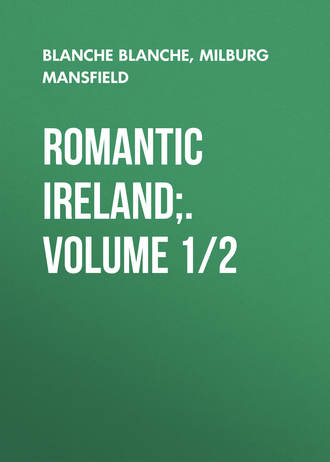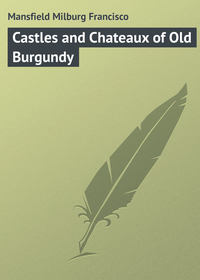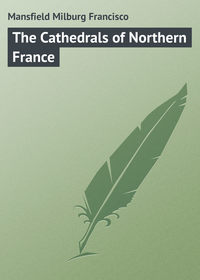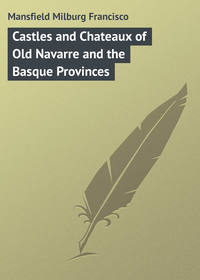 полная версия
полная версияRomantic Ireland;. Volume 1/2
The old though unidentified adage, “When in Rome do as the Romans do,” should be more largely applied by all whose province and wish it is to roam, as, for instance, “When abroad do as the natives do.” Thus, when in Ireland, keep away from the establishments which cater for the “tripper” pur sang; follow the unworn track, which, perhaps, will lead you now and then into a quandary, but which will mean no great hardship or inconvenience, and, on the whole, will give one a far more interesting and satisfying view-point than any other, and a knowledge of the land and the people which is positively profound, as compared with the usual variety.
For the rest, it is urged that the traveller, either for education or pleasure, be forewarned and forearmed as to the possibility of time slipping away unawares, and his not being able to accomplish all of what he may have set forth to do. This will most likely be the case; but he should curtail his tour abruptly and not by piecemeal, omitting, if necessary, the northerly portion entire, and returning to Dublin from Galway or Sligo. By no means, however, should he cut out the western highlands, or even Achill, for here lies that which is, as yet, the part of Ireland least known to the great mass of tourists.
It is taken for granted that he will feel that he must, happen what may, “do” the Killarney district; and, after all, if it is the most sentimental and daintily composed of all the land, it is not the less appealing to him who is strong of girth and rugged in his instincts. It is, moreover, the region wherein are to be found the most complete “creature comforts,” as civilization knows them, albeit the charges for them may in many cases rise to heights which are unknown outside of really fashionable tourist points. Still, in this respect, there has been a great improvement of late, and, unless one insisted upon surrounding himself with those more or less unnecessary adjuncts of a metropolitan life, – which he ought to have left behind him with his other cares, – he will find that, for simple and comfortable accommodation, he will need to pay no more than in that Mecca of the cheap tourist, Brittany.
The hotel accommodations of Ireland have often been reviled; but, if not luxurious, they are at least as comfortable as in many other more popular regions, Brittany, North Spain, or Tuscany, for instance; and, while large and populous modern towns are not frequent, accommodations of an acceptable character are to be found in most places where the traveller has a right to expect them.
The many and varied elements which make Ireland attractive unconsciously weave a spell which, mayhap, will allure many another to seek for himself the charm of Ireland, in preference to all other neglected tourist points. It certainly stands first and foremost as a new touring-ground for those who would not perforce wander too far afield, or at too remote a point from a metropolitan daily paper.
Not that the mountain fastnesses or the isolated headlands and unfrequented lakes and loughs are always within quick communication with more populous centres of civilization. Far from it; one may journey many a weary hour from some remote hamlet in order to strike again the railway which is to take him to some newer and possibly more appealing centre of interest; and, when he reaches that same railway, or one of its newly made tentacles, which are for ever reaching out toward new lands to conquer, he may be forced to pass an equally lonely, though perhaps awe-inspiring, vigil at the base of some bald, bare mountain-peak, awaiting the main line connection which was due at this point a couple of hours before. All of which, were one imbued with anything but the spirit with which he ought to be imbued, might gall and chafe, with some sense of reason, but which, for the true vagabond, even though he may not choose to travel by foot and on the road, ought to be the very essence of enjoyment.
CHAPTER III.
THE LAND AND ITS PEOPLE
ONE hundred or more years ago, when Arthur Young first wrote his journal of a tour in Ireland, those who had Ireland’s welfare most at heart deplored the fact that “her greatness was still practically unexplored, and the early history of her brighter days excited no interest even among her own people.”
Doctor Johnson felt this himself when he wrote, “I have long wished that Irish literature were cultivated, as Ireland is known by tradition to be a seat of piety and learning, … and surely it would be very acceptable to be further informed regarding a people at once so ancient and illustrious.”
It has been said, too, – the words are taken from the mouth of a poor parish priest, – that “the Celt is melting like the snow: he lingers in little patches in the corner of the field, and hands are stretched on every side. It is human to stretch hands to fleeting things, but as well might we try to retain the snow.”
From this it would appear that Ireland and its institutions, as they have existed in the past, and as they exist to no small extent to-day, are not yet the familiar ground that many might suppose.
Just what the reason for this indifference to its charms may be, it is impossible for any one to state; but, at all events, it is traditional to a large extent, and is a long time being lived down.
During the period of the varied fortunes of the ancient kings of Ireland’s four great divisions – from perhaps the fifth century until the coming of Henry II. of England – there was little connection between Ireland and the outside world, excepting always the Church which attached Ireland to Christendom.
It was, perhaps, small wonder that the Plantagenet Henry, who was in favour at Rome, was desirous of uniting the four kingdoms of Ireland as a Roman Catholic whole. He had already sent three bishops to Rome, and its most famous of all “Irish bulls,” if the levity be pardoned, came forth naturally from Nicholas Breakspeare, the English Pope.
The Church in Ireland, or, rather, religion in Ireland, is a subject that one approaches with dread. So much so, that it had best be avoided altogether so far as its controversial elements are concerned.
The real significant ecclesiastical aspect of Ireland of the past – or of the present, for that matter – can be discussed with less trepidation.
Of the devotion of the people to their Church there can be no question, though it smacks not a little of the devotion of the ivy to the tree.
It has been said before now that “the houses of the people are indecently poor and small, and the houses of the Church are indecently rich and large. Out of the dirt and decay they rise always proud and sometimes ugly and substantial, as though to inform the world that at least one thing is not dying and despondent, but keeps its loins girded and its lamps trimmed.”
All of which is, – or was, – perhaps, true enough in the abstract; but, tempus fugit, and Ireland, if not actually grown, as yet, more prosperous, or, in many parts, any less primitive, is without question becoming, throughout, more enlightened; and the traveller, walking or driving across the wastes of the west, will not cavil at the fact that the first thing to break the monotony of the horizon is a church spire or tower, or that it towers over a little group of cottages huddled about it. Sometimes, indeed, these church buildings are poor and rough; but these are becoming fewer and fewer, and are now gradually, even in the poorest districts, being replaced by more pretentious structures. The last few years have seen in Ireland a great activity in the building of these chapels, though they are not always of the artistic value of many of the older examples.
The economists and political agitators have, of late, drawn attention to the “positive sinfulness” of the increase of chapels and religious buildings side by side with the increase of poverty. This may have existed up to the last half-century, but, as surely as the seasons change, a new era for Ireland is close upon it, and the increase of what is called the “religious vocation” is not the bugaboo that it once was.
One should pay a hearty tribute to the patriotic efforts of the Gaelic League to inspire throughout Ireland a wholesome and invigorating sense of nationality, and to guide its energies into industrial and intellectual channels. This movement, from within and without, is doing noble work, and, if it is uninterrupted in its progress by religious or political jealousies, Ireland may yet come to her own again.
More than seven centuries have rolled onward since the English have become intimately connected with Ireland, and yet how little is really known of the land and its people, in spite of all that the political economists, the ecclesiasts, and the antiquarians have written concerning it.
Professor Van Raumer, a German, in his “Letters from Three Kingdoms” (which it is only proper to say has been criticized before now as a mass of bold trivialities and solemn inaccuracies), says that he never knew what poverty meant until he travelled in Ireland. Its existence, to a very large extent, is undeniable; and, in times of stress and strife, it has even become virulent; but ragged dress, frugal fare, and mean houses do not always indicate actual distress. The trouble seems to be with those who commit themselves to written observations that they never appear as apologists, but condemn, from the start, anything and everything which falls below a certain preconceived standard which they may have unknowingly set.
In spite of the fact that the population in certain parts of Ireland was proclaimed as being, at the beginning of the Victorian era, at its lowest ebb, – in many parts of Ulster conditions have since changed but little, – there was often no apparent haggardness or lack of nourishment to be observed; the children notably, like the children of the slums in great cities, were rosy, chubby, and high-spirited – a very good indication of the general health of a community. This is one of the anomalies of travel and observation which cannot be explained.
A statement was made in the public prints, at the beginning of the year 1903, that Ireland had lost, in the twelvemonth previous, a population equal to that of Limerick, the fourth largest Irish municipality, and greater than that of at least one Irish county (Carlow). This awful drain by the outflow of the virile young of both sexes should be controlled by the well-wishers of Ireland’s prosperity.
What the future is to bring forth for Ireland is doubtless quite problematical; but there is no gainsaying that the hour is ripe for any action which it may seem advisable to take. It is difficult to believe that even the fieriest of the patrons of Ireland can fail to perceive England’s present willingness to make what perhaps she thinks is a sacrifice, but which in any event is intended as an atonement for the past, and an eager desire for the prosperity of the country at her doors. There are many respects in which Ireland is eminently fitted by nature for prosperity. There is hardly to be found anywhere in the world such natural facilities for the development of a great mercantile marine as exist on the eastern coast from Londonderry and Antrim to Waterford and Cork, and Belfast to-day contains one of the world’s greatest and most able ship-builders. There is, it is said, no part of the country which stands at a greater distance from a waterway to the sea than four and twenty miles. The country has immense stores of iron, still unutilized, mainly because of the scarcity of native coal; but some day, in this epoch of cheap and rapid transportation, they will yield a rich harvest. There was once a considerable industry carried on in the copper-mines of counties Waterford, Wicklow, and Cork, but of late it has greatly declined. So it is with the sulphur-mines of Wicklow, which at one time yielded nearly a hundred thousand tons per annum. The bogs, which cover one-seventh part of the surface of the whole island, have never yet been turned to such economic uses as most certainly await them – the production of a really well-cured compressed peat fuel. There are vast deposits of lignite, already proved to be of great depth, but which can be worked on a large scale only at a greater expenditure of capital than has yet been applied. In point of fact, Ireland is potentially a rich country, but her mineral deposits have been practically neglected. It will be a happy day for England when she finds, as she yet may, a prosperous and contented Ireland at her doors.
A prosperous Ireland means, ultimately, a healing of whatever sore remains open; and may, perhaps, mean the removal of the last bar against the real federation of the English nation. The recent visit of Britain’s king and queen may be taken as a good omen, and its effects may turn out to have been far-reaching. At its least, it stimulates good-will on either side, and does its own quota of work in the inspiration of a hopeful spirit in a natively buoyant people, who have long chafed at neglect. At its best, it may hope to make one of the loveliest countries in the world a place of popular resort, with the inevitable result that its advantages will become more widely known and better exploited than they have hitherto been.
It has long been the opinion of many Irishmen, and of many British well-wishers of Ireland, that the permanent establishment of a royal court would be of much service to the country. It is claimed that this idea is not dictated by any spirit of “flunkeyism,” but rests on a sound business basis, which, after all, if a sordid view, is an essentially practical one. Such a court would promote trade, and trade would feed industries that are now starving; and, while it would carry these material blessings in its train, it would have its proper sentimental value also, and would do its share, and no small share, either, in the final reconciliation of two countries which have long, to their common disadvantage, been divided.
Any one who reads has heard considerable of “the unfinished chapter” of the nineteenth century of Ireland; how Ireland “oft doomed to death, is fated not to die;” and of “the Exodus.” Yet, after all, these affairs of apparent moment have really very little import to-day. Ireland is by no means dead, nor ever will be, as things point now.
The history of Ireland during the past hundred years has indeed been vivid. So has the history of most other lands. It is merely a sign of the times.
The year 1849 found Ireland in as wretched a condition politically, and socially, as she ever had been. 1846 and 1847 had been famine years, when people lay perishing and the land lay untilled. No crops were raised and no rents were paid. The corn laws had come into effect in England, and the tax on foreign corn, which gave to Ireland a real advantage with respect to grain, was withdrawn. The economists advised cattle-raising as a substitute, and pointed to the fact that, as an English statesman had said, “Ireland was clearly intended to grow meat for the great hives of English industry.” How the transformation from a grain-raising to a cattle-growing country was to be made, instantaneously, he did not say.
The project did not receive immediate favour, as might be presumed, and was the real cause of the impetus given to migration to the United States, “the home of the free.”
The streams of fugitives swelled to dimensions that startled Christendom; but the English press burst into a pæan of joy and triumph – for now at last the Irish question would be settled! Now at last England would be at ease. Now at last this turbulent, disaffected, untamable race would be cleared out. “In a short time,” said the London Times, “a Catholic Celt will be as rare in Ireland as a red Indian on the shores of Manhattan.”
The press, indeed, in England, was most uncharitable, and, assuredly, in more instances than one, quite ignorant of that about which they were writing.
Religion was, of course, their chief point of attack. It is always a safe card to play, if one wants notoriety merely, not only for as impersonal a thing as a public journal, but for an individual as well.
The Irishmen who remained, the emigrants’ kindred, their own flesh and blood, their pastors and prelates, could not witness unmoved this spectacle, unexampled in history; the flight en masse of a population – as it then seemed, and the figures are truly astonishing – from their own beautiful land, not as adventurers, but as heart-crushed victims of expulsion. Some voices, accordingly, were raised to deplore this calamity; to appeal to England; to warn her that evil would come of it in the future. But England did not see this; at least, did not see it then. There were philosopher-statesmen ready at hand to argue that the flying thousands were “surplus population.” This was the cold-blooded official way of expressing it; but the English press, however, went farther. They called the sorrowing cavalcade, wending its way to the emigrant ship, a race of assassins, creatures of superstition, lazy, ignorant, and brutified. The London Saturday Review made the following reply to a very natural expression of sympathy and grief wrung from an Irish prelate witnessing the departure of his people:
“The Lion of St. Jarlath’s surveys with an envious eye the Irish exodus, and sighs over the departing demons of assassination and murder. So complete is the rush of departing marauders, whose lives were profitably occupied in shooting Protestants from behind a hedge, that silence reigns over the vast solitude of Ireland.”
Volumes might be filled with the same sort of comment, and yet other volumes with an impartial review of events as they really were; but even then the story would not be told, and hence the impossibility of entering into the controversial aspect of the question here.
Tears may trickle down the cheeks, and hearts may palpitate with emotion, when the sons and daughters of the soil view for the last time the streams which sparkle in the glens, the lakes which bosom themselves in the mountains, and the bowers of fairyland with which every Irish wood is endowed; but, yet, one may depend upon it that as bright or a brighter future awaits the emigrant who goes out into the world than remains for him who stays at home.
It seems paradoxical to see in emigration at once the hope and the curse of Ireland; but, after all, perhaps it is not wholly a detriment. The area of Ireland is comparatively small, its productiveness limited, and its population still relatively great, in spite of the fact that some five millions have emigrated to America alone since 1840.
Manifestly it has been for years, and must be for some years yet, mainly emigration to which Ireland must look for improvement of the social conditions of those who are left behind – provided, of course, that home conditions are sufficiently encouraging to the tillers of the fields, the cattle-growers, the men and women in the great flax and linen factories, the ship-building establishments, and the fisheries. These industries alone, with the increasing trade outside their own country for the native products, ought in a measure to win increased prosperity.
In addition, too, it is fondly hoped by many, and predicted by a few, that a great tide of tourist travel will turn toward Ireland, and that, in time, it will become as busy catering to the wants of pleasure-loving tourists as are Switzerland and Norway.
Perhaps this is not altogether to be desired, from many points of view, but it appears inevitable.
The political aspect of affairs in Ireland is ever and ever improved by the periodic and frequent visits of royalty. These ought to do much good, for the idea should be fostered that the people of Ireland have the same king as Britain across the Channel. Some there be, in both islands, who would have this forgotten, and many happy ideas for the encouragement of Irish affairs have been strangled by hands both from within and without the green isle.
Forgetfulness may account for this, but more probably it does not, and many entirely ignore the fact that Great Britain’s king has also the words “and Ireland” attached to his title. At the end of a recent visit of King Edward, the London papers, almost without exception, referred to his return as a “home-coming,” as if he had returned from an alien shore.
The fact was passed unnoticed, apparently, but there was a sting in it which the Irish themselves, one may be sure, did not overlook.
The Irish land and tenant problem is one which cannot be ignored, and has given great concern to those responsible for Ireland’s welfare.
It is impossible, and it would not be meet, to attempt to deal, even superficially, with the question here; but it cannot be overlooked by one who knows anything of Ireland and the present-day aspect and conditions of life there; nor can it by even the “butterfly” tourist, who does the round of Killarney’s fair lakes in a personally conducted party. Even he, if he is at all observant, will see evidences of certain conditions of life with which he has not become acquainted elsewhere.
The question for the landlords – leaving the rights and wrongs out of it – was, and is, how rentals can be collected.
It certainly cannot always be expected to be paid out of the land. The eight or nine acres of reclaimed bog-land, which often constitute the tenants’ holding, can produce nothing in the nature of rent after the occupants have secured any sort of subsistence. But that is only half the case. There is, or is supposed to be, another very large class of holdings in the poorest districts, which cannot even produce a bare subsistence for an average family. It is possible that the demerits of bog-land are greatly exaggerated. When reclaimed it is, it is said, in a sense, easy to till and productive. But, on the other hand, it rapidly impoverishes itself and deteriorates by periodical flooding, – the curse of all the west, – and its productivity is but comparative.
On the De Freyne estate at Castlerea there are hundreds of acres of rich grassland with scarcely a house upon them, “cleared” years ago by the landlord when prices were high and there was a chance of profitable sales, – which sales, however, apparently did not materialize. On the other hand, there are hundreds of acres of bog-land, with the little cabins crowding close upon one another as far as the eye can see, which certainly indicates that there is a demand for this class of holding. Rents are not high, as rents go elsewhere; but they cannot be paid out of the land, and the sons and the daughters, in order to live, must leave it. In cottage after cottage one may hear the same story. An old man and his wife with one daughter left at home; two sons in England; two daughters in America, – all sending over a pound now and then to keep the roof over their parents’ heads. And these people cleared the land themselves. “It was all red bog, sorr, like yon,” they tell you.
A peasant in the townland of Cloomaul gives these figures. He is sixty-seven years old, and until 1860 the rent of his holding was £5 a year. In 1860 it was raised to £11 5s. 0d.; twenty-eight years later the Land Commission reduced it to £6 5s. 0d. Meanwhile great became the stimulus to emigration, and once again the old story of “me sons beyond the sea” is given out. In some sections there is scarce a young man or a young woman to be seen. The evictions, that throughout Ireland raise the countryside as nothing else does, only bring together, with a few rare exceptions, a band of women, children, and old men. The hay harvest in England calls many of the able-bodied away temporarily, and the colonies and the United States call those who would go farther afield.
The moral aspect of the whole problem is thus put in a nutshell by the economists and Ireland’s well-wishers:
“Irish landlordism to-day represents little more than an enormous tax upon the industry of the people. It does nothing in return for the money it receives. It is, to a very large extent, non-resident. Much of it is in a bankrupt condition.”
And no wonder, when one remembers the vast proportion that is “spent out of the country.”
Mr. T. W. Russell, M.P., contributed a recent paper to the New Liberal Review on “Disturbed Ireland.” In it he takes a very gloomy view of the present situation. He says that a grave crisis is rapidly approaching, which will shake things to their foundations in Ireland; and points out that since 1868 the whole of the Irish governing class has been disestablished and disendowed. Before that year, Ireland was governed by its Protestant landlord garrison. First by one measure of reform and then by another, every cartridge has been withdrawn from the bandoliers of the garrison, which is now as powerless as it was once all-powerful. England is dealing with an absolutely crimeless country. White gloves are the order of the day, blank court calendars are reported all over the country, yet boycotting is wide-spread, and intimidation is rampant. A conspiracy to boycott is punishable, but boycotting is not in itself an offence. Hence the great part of the country has passed under the dominion of the United Irish League. What the future will actually bring forth for “poor, distressed Ireland” it is impossible to predict, but it may be presumed that other lands will go on enriching themselves by the accumulation, as citizens, of the flower of Ireland’s flock, and that this is in fact but a natural enough thinning-out process, which has obtained among other nations before now.









